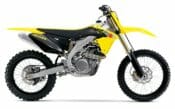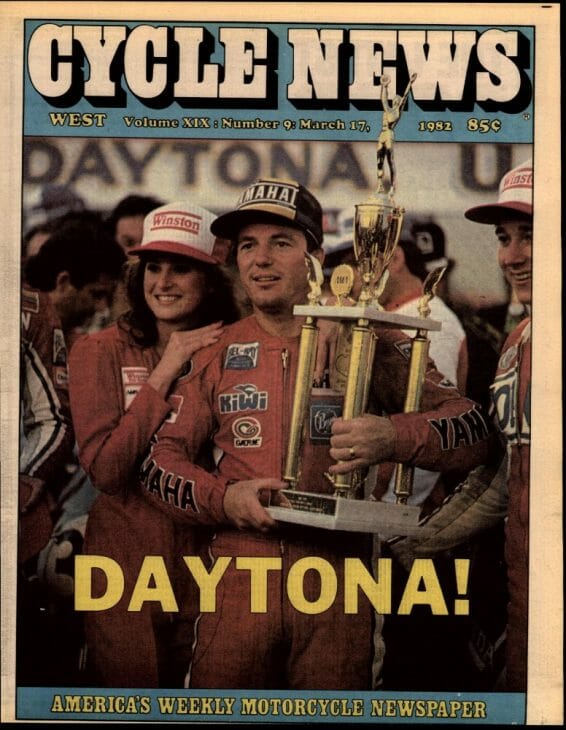
Graeme Crosby emerged from the highly-competitive production road racing of his native New Zealand and neighboring Australia, made his name at the prestigious Suzuka 8 Hours and rose to the highest levels of Grand Prix road racing. Along the way “Croz” won iconic events like the Isle of Man TT, the Daytona 200, the Imola 200 and the Suzuka 8 Hour. Crosby even scored a pair of world championships in the old Formula One TT Series.
Crosby raced three seasons in 500cc Grand Prix (MotoGP World Championships and got better every year, ultimately finishing runner up to Franco Uncini in 1982. But after that outstanding campaign, and at the peak of his career, Croz left the racing world stunned when he walked away from the sport.
Crosby is considered by many pundits as one of the best riders to never win a Grand Prix, but the aggressive-riding, hard-drinking and fun-loving Kiwi certainly made a major impact on the sport in spite of missing that particular milestone.
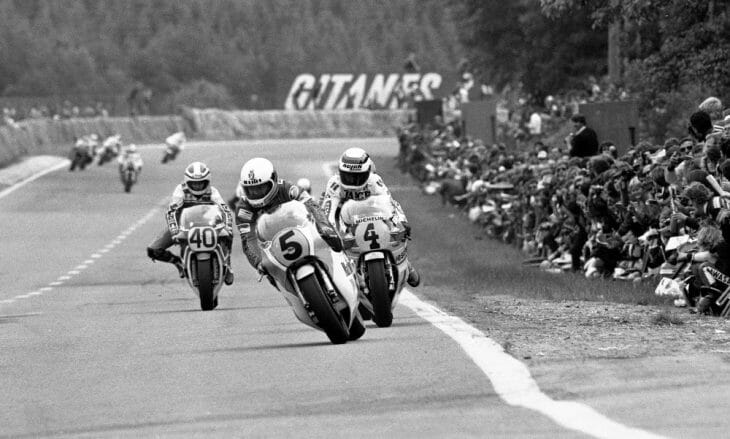
Crosby leads at the Belgium Grand Prix in 1982. (Henny Abrams photo)
Crosby came up early in the production-racing craze that arose in the 1970s. His early rides on Kawasaki Triples and later on Z1s eventually caught the eye of an Australian team owner who brought him on board to race in the burgeoning Australian road racing championships. Endurance racing was popular there and Crosby rapidly gained hundreds of racing miles in those competitions. The team owner he raced for happened to be a Yoshimura importer and that led to Crosby get the call to race with Pop’s Yoshimura’s son-in-law Mamoru Moriwaki, of Moriwaki Engineering in Japan, to race in the first Suzuka 8 Hour in 1978.
Suzuka almost instantly became one of the most prestigious road races in the world and Crosby was one of the event’s top riders. (He and Wes Cooley teamed to win the race on a Yoshimura Suzuki in 1980.) Moriwaki rewarded his exciting new find by sponsoring him to race select British contests and World TTF1 events.
In the late 1970s Crosby was racing at so many tracks for the first time his catchphrase became “Which way does the track go and what’s the lap record?” Croz notes that phrase, full of bluster, garnered a rather scornful look from one stodgy British track marshal.
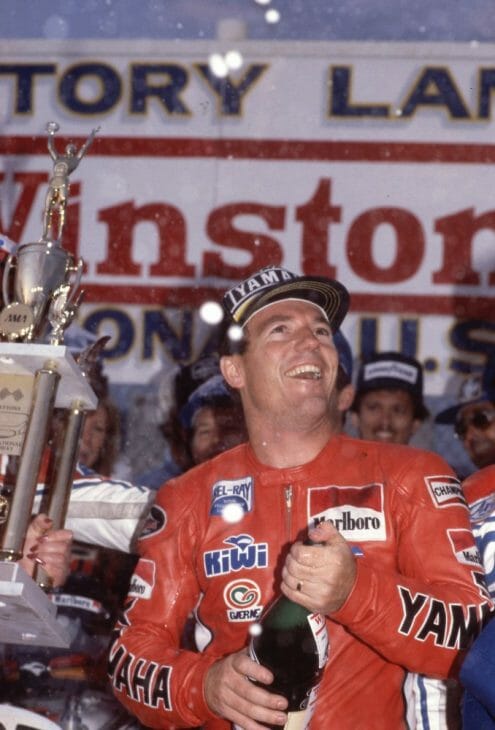 In Victory Lane after winning the 1982 Daytona 200. (Henny Abrams photo)
In Victory Lane after winning the 1982 Daytona 200. (Henny Abrams photo)
Daytona 1980 was part of Crosby’s world-hopping racing schedule. Of course, before he’d even made it to the track, Croz found some Irish fans who’d had come over for Bike Week and together they hit the bars. He and his rowdy new friends got his Mustang rental stuck on the beach at 3:00 am and they watched with nervous laughter as waves broke over the car by the time a tow truck arrived.
On the track at Daytona for the first time, the stress of watching his rental car drown, was quickly outdone by his terror at racing full-speed around Daytona’s High banks.
“The first few laps scared the shit out of me because of the combination of extreme banking and the high speeds,” Crosby admitted. “I had never experienced the positive G-forces that exerted extra pressure on my head and probably doubled its weight.”
In a qualifying heat for the Daytona Bell Superbike 100 he’d finished second to teammate David Aldana, or at least that’s what he thought. Even though both had taken the checkered flag, they each did a plug chop and pulled off the track at the entry of turn one and pulled back into the pits. The AMA informed them they hadn’t gone past the turn one scoring tower, so weren’t scored in spite of passing the finish line and taking the checkered flag.
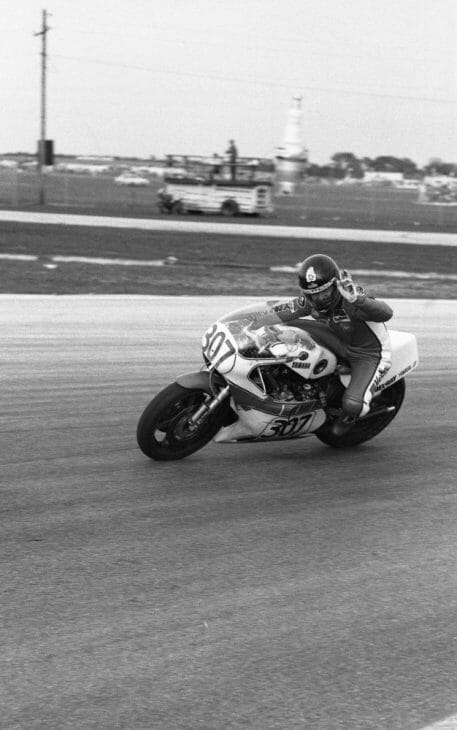 Croz waves to fans after winning at Daytona. (Henny Abrams photo)
Croz waves to fans after winning at Daytona. (Henny Abrams photo)
The ridiculous rule and resulting penalty forced them to start from the back of the field. It infuriated Crosby. He used that fury to absolutely mow through the field en route to battling Honda’s Freddie Spencer late before taking the surprising victory. By then Crosby had already been competing in British events and large contingent of British fans who were on hand for Daytona went nuts when their man took victory.
On his cool-down lap it was classic Croz. He pulled up to the scorer’s building and stopped, pointing to himself as if to say, “Did you get that?”
The next year Crosby came up just a few bike lengths short of winning a second Daytona Superbike race. He was edged at the line by Yoshimura Suzuki teammate Cooley.
In 1982 Crosby, by now a third-year Grand Prix rider, now riding for factory Marlboro/Agostini Yamaha, he came back to Daytona again and this time won the big one, the Daytona 200. He raced a steady race while almost all the other top runners experience problems in a race of high attrition.
Honda came loaded that year with the potent FWS1000 1000cc V-4 Formula One bike ridden by Freddie Spencer and Mike Baldwin. In the race Croz and his Suzuki GP teammate from the year before, Randy Mamola, came together in the first turn and Mamola went down, ending his race. Mamola’s manager Jim Doyle bitterly protested afterwards in winner’s circle that it was an intentional move by Crosby – a payback for Suzuki keeping him on the factory GP squad instead of Crosby. But Crosby denied the claim.
“I was online with the rest of the riders going through the first turn and Randy had ridden wide,” Crosby said. “He was trying to merge back into the pack and he hit me.”
Baldwin, Spencer, Kenny Roberts and Eddie Lawson all shared time at the front. Eventually all the leaders began having issues. Roberts and Lawson’s bikes broke and the FWS Honda’s were chewing up tires and sucking gas at a massive rate, requiring extra pit stops. Halfway through Crosby took over the lead and then held off a late charge by Spencer.
Crosby won $12,000 ($30,000 in today’s dollars) for the victory and spent a couple of days celebrating on the beach and the bars. Before leaving town, Crosby came back to the Daytona offices to say goodbye to the staff.
“While no one was looking, I managed to grab a very nice photographic montage of me in the winner’s circle,” he later admitted.
Typical Croz.
He had a great year on the GP circuit, but frustrated by the internal politics of Agostini’s GP squad, Crosby quit the Grand Prix circuit after the 1982 season. He also wanted to pursue a career as a pilot.
After his retirement, Crosby returned to New Zealand and ran a number of successful motorcycle businesses. He also took up Touring car racing.
Crosby’s autobiography entitled CROZ – Larrikin Biker was published in 2010.
Today Crosby is semi-retired and enjoys restoring vintage motorcycles at home in New Zealand. While his racing appearances in America were limited, he quickly became a fan favorite here for his admitted full-bore lifestyle, his exuberance and of course his raw riding talent.
